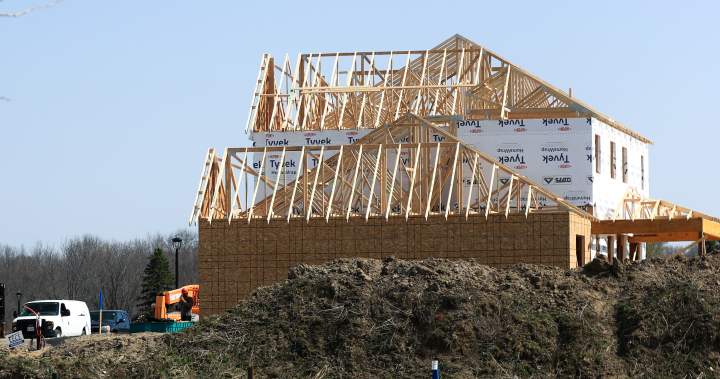Municipalities have $10B from developers saved up. Ontario says they should spend it now

The Ford government is accusing Ontario’s major towns and cities of “sitting” on billions of unspent dollars amidst a growing housing crisis, telling them the money should be used to reduce the cost of building.
According to data shared by the provincial government, Ontario’s 444 municipalities have roughly $10 billion in the bank between them, funds collected from developers building new housing projects.
The data, which Global News requested from the Ministry of Municipal Affairs and Housing, shows Toronto has $2.8 billion, Durham Region has $1.1 billion and the City of Ottawa has collected over $800,000.
Brampton’s development charge balance, as of 2023, sits around $412,000. Vaughan’s is at 543,000, while Mississauga’s has roughly $414,0000.
It’s money the provincial government argues municipalities should spend — and quickly — to reduce the cost of building new homes.
“Municipalities across Ontario are sitting on $10 billion of development charge reserve funds — funds that could be used to get shovels in the ground,” a spokesperson for Municipal Affairs and Housing Minister Rob Flack told Global News.
“The changes we are making through the Protect Ontario by Building Faster and Smarter Act will ensure municipalities allocate at least 60 per cent of their development charge reserves, following the examples of Vaughan and Mississauga, who are already using these reserves to reduce building costs and support new housing.”
Developers continue to complain that it is too expensive to build new homes in Ontario, despite various fees being reduced. Housing starts across the province are down compared to 2024, which was also a decline from the year before.
Municipalities, however, argue the money they have in their reserve accounts isn’t simply sitting there.

Get breaking National news
For news impacting Canada and around the world, sign up for breaking news alerts delivered directly to you when they happen.
In Toronto, for example, a spokesperson said the $2.8 billion reserve fund weighs against a 10-year building plan worth $6.1 billion. “We are also now at a point in time where we are spending development charges at a faster pace than we are collecting them,” they said.
Similarly, Mississauga — where the mayor slashed development charges — is predicting a shortfall when spending commitments are taken into account.
A spokesperson for Durham Region said that “funds currently held in the DC reserve funds have already been committed to capital projects that are either underway or about to commence.”
Vaughan, which has made cuts to its DCs, said the changes the provincial government would not have a negative impact on its balance.
The Ministry of Municipal Affairs and Housing urged the cities to use the money in their accounts to unlock new housing.
“We continue to encourage municipalities across the province to use their reserve funds to build more homes in their communities,” they said in a statement.
Burlington Mayor Marianne Meed-Ward, who also chairs the Big City Mayors’ caucus, said the “narrative that development charges hold up housing or make it less affordable is a destructive distraction.”
“There’s this narrative, there’s a single DC rate for everybody and it’s too high — without any kind of understanding DCs are developed in the community, with the development industry, based on very restrictive provincial restrictions,” she said.
“So I can’t collect a DC for a community centre and spend it on my fire department. I have to spend it on what it was intended for, it’s very prescribed.”
In 2022, the Ford government announced audits into the development charge accounts of major municipalities, alleging at the time that they were sitting on billions. Those audits were never made public.
Since then, the province has made a number of changes to how development charges work, what can be collected and how they can be spent.
In its latest legislation, Ontario reduced the scope and number of studies municipalities can require for new developments, sped up certain minor variances and standardized and streamlined development charges.
It also allows municipalities to more easily reduce development charges, allows residential builders to pay those fees at the time of occupancy instead of when a permit is issued and exempts long-term care homes from the fees in order to spur their development.
Many of those changes, unlike previous tweaks, were suggested to the government by homebuilders and municipal advocates together.
Lindsay Jones, the director of policy and government relations for the Association of Municipalities of Ontario, agreed that “municipalities are not hoarding development charges.”
She said, however, the system would benefit from changes.
“There’s no question that there’s been really significant shifts in the market, in the overall macroeconomic context, and in the realities of incomes for Ontarians since the development charge regime was put in place almost 30 years ago,” she said.
“No question, there are ways that it can be improved — and we are optimistic about the potential for Bill 17 to be able to have some positive impacts.”
— with a file from The Canadian Press
© 2025 Global News, a division of Corus Entertainment Inc.


Spirits maker Diageo will cease operations at its bottling facility in Amherstburg, Ont., early next year, as it shifts some bottling volume to the U.S., the company announced on Thursday.
The facility, which bottles Crown Royal products, will close in February in a move aimed at improving its North American supply chain.

Get breaking National news
For news impacting Canada and around the world, sign up for breaking news alerts delivered directly to you when they happen.
About 200 jobs will be affected.
“This was a difficult decision, but one that is crucial to improving the efficiency and resiliency of our supply chain network,” Marsha McIntosh, Diageo’s president of North America supply, said in a statement.
Diageo said it will engage with the community and find ways to support its employees through the transition, and work alongside Unifor to assist unionized workers.
The company said it will still maintain a “significant” footprint in Canada — including its headquarters and warehouse operations in the Greater Toronto Area, and bottling and distillation facilities in Manitoba and Quebec.
McIntosh added the company’s Crown Royal products will continue to be mashed, distilled and aged at its Canadian facilities.
© 2025 The Canadian Press

Toronto police say a 33-year-old man has been charged with attempted murder after allegedly striking two men with his car Wednesday evening.
Officers say they responded to reports of a collision in the area of Don Mills Road and Gateway Boulevard in the city’s North York neighbourhood just before 10:30 p.m.

Get daily National news
Get the day’s top news, political, economic, and current affairs headlines, delivered to your inbox once a day.
Police say two men got into an argument, leading to one man getting into his car and hitting the other man with it.
They say the man then put his car into reverse, striking a second man.
A man in his 50s was transported to hospital with serious injuries and the second man, in his 20s, had minor injuries.
Police say the suspect from Markham, Ont., faces several other charges as well, including two counts of assault with a weapon, uttering threats and dangerous driving.
© 2025 The Canadian Press

A court document shows a Lindsay, Ont., man facing charges for allegedly breaking into an apartment was carrying a crossbow when he was confronted by a tenant.
The resident, Jeremy David McDonald, is also facing assault charges in the incident on Aug. 18 — a fact that has generated widespread interest in the case.
Police information filed in court alleges that Michael Kyle Breen damaged a window and screen at McDonald’s home and carried a crossbow.
The court document says the 41-year-old Breen is charged with break and enter, possession of a weapon for a dangerous purpose, mischief under $5,000 and failing to comply with a probation order.

Get daily National news
Get the day’s top news, political, economic, and current affairs headlines, delivered to your inbox once a day.
Police have said that Breen, who is scheduled to appear in court for a bail hearing next week, was already wanted for unrelated offences.
McDonald, the 44-year-old resident, was charged with aggravated assault and assault with a weapon after he allegedly “did endanger the life” of Breen.
Premier Doug Ford blasted the decision to charge the apartment resident, saying last week that it shows “something is broken.”
Kawartha Lakes Police Chief Kirk Robertson wrote in a statement Wednesday that he recognizes the incident has generated significant public interest and “emotional” responses, but called some of the reaction “unjust and inaccurate.”
Robertson wrote that individuals have the right to defend themselves and their property, but the law requires that any defensive action be proportionate to the threat faced.
“This means that while homeowners do have the right to protect themselves and their property, the use of force must be reasonable given the circumstances,” he wrote.
© 2025 The Canadian Press
-

 Uncategorized3 months ago
Uncategorized3 months agoShop Proud, Eat Proud, Be Proud — Ottawa Canada Day Market This June 28th
-

 3 months ago
3 months agoCanada’s world junior trial saw juries tossed, intense testimony. Here’s a recap
-

 2 months ago
2 months agoRing of Fire road to bring prosperity to First Nation, problems for caribou: report
-

 2 months ago
2 months agoMeasles circulating in northeastern B.C. community, health officials warn
-

 3 months ago
3 months agoAnishinabek Nation chief says he briefed Ontario police on protests against Bill 5
-

 2 months ago
2 months agoFormer major leaguer, Jays doctor Ron Taylor dies
-

 2 months ago
2 months agoJagmeet Singh apologizes for attending Kendrick Lamar concert after Drake calls him out
-

 2 months ago
2 months agoDreaming of a lakeside cottage but can’t afford it? Co-ownership could open that door



